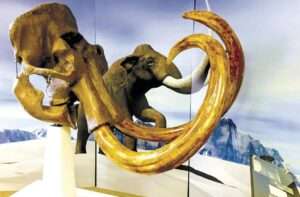By Carol Fisher-Linn
Randolph’s 12,000+ year-old wooly mammoth returns home to stay.
Ever wonder what it would be like to see a prehistoric animal up close and personal?
We live with a new reality these days – daily air quality reports warn us to stay indoors or to wear masks when the ash and smoke drifting from the Canadian fires reaches us. Fires in the north. Fires in the west. Years of fires destroying land, homes, animal habitat and living things. Imagine if the fires got totally out of control and one tenth of the earth was suddenly covered in roaring fires all at the same time. Well, this was indeed a possibility, according to a study from the University of Kansas. Adria Melott, who co-authored the 2018 study detailed a similar catastrophic event 13,000 years ago. (Sciencealert.com)
According to the study, the fire may have been even greater than the ones that wiped out the dinosaurs. It is theorized that this one was caused by comet fragments that may have measured about 62 miles across. That would be the distance from Salamanca to the Peace Bridge. A BIG comet. Yet, not as large as one discovered in 2014, announced in 2021 and reported in National Geographic (9/29/2021) called Bernardinelli-Bernstein, whose nucleus is estimated to be 93 miles wide. We can only hope that that one never hits the earth but just keeps on its course in the heavens.

Because of that 62-mile-wide comet smashing somewhere into the earth over 12,000 years ago, dust storms covered the earth causing a mini-ice-age. One could possibly compare it to the effects from the eruption of Mount Tambura in Indonesia in 1816 which caused the ‘year of winter’ across the globe. Or, more dramatically, the eruption of Mt. Toba in Sumatra 70,000+ years ago (Britannica.com). Unfortunately, this particular event occurred just as the earth was finally coming out of being covered by glaciers for over 100,000 years. This new occurrence kept the planet cool for another thousand years. It took the fires finally burning themselves out before life on earth could begin once again. Or so the study hypothesizes.
So, let’s go with that hypothesis and think back to that catastrophic event. 3.86 million square miles of the world would have been impacted and would eventually become a frozen mass – no food sources, no food for animals and no animals for food (only 29% of the total world’s surface is land). Although the theory does not identify where this incident occurred, it’s not inconceivable that it could have happened right here in Western New York. That theorized event might explain how a wooly mammoth from 12,000 years ago appeared deep under the soil in Randolph. This wooly was discovered in 1934 as workers were clearing soil while enlarging the Randolph, NY fish hatchery.
Since there don’t seem to be any fuzzy Polaroids or faded post cards in museums from that epoch, we don’t have much in the line of eyewitness accounts of living mammoths. Yet, there was its remains, in all its splendor. Lying there for what is calculated to be 12,000 years. After he was found, he was scooped up and placed in climate-controlled storage by the preservers and curators of the NYS Museum in Albany. It is reported that the head, weighing 200 pounds, was deteriorating, so a cast replica of its remains was created for public viewing. The original tusks can give observers a good idea of the size of the living animal. And, yes, one can see these tusks and this head replica once again in Cattaraugus County at the library in Randolph, where it will hopefully reside for a long time. It is purported to be “on indefinite loan” from the NYS Museum. A large representation, in the form of a picture, of a fully intact mammoth next to a modern-day elephant and a man, was generously given to the museum by the Roger Tory Peterson Institute. They displayed that picture with the mammoth head when it was on view at RTPI in 2011-2012. It is now included in the Randolph library display. The library is located at 26 Jamestown Street. Hours from their website are Monday, Tuesday, and Thursday 12pm to 8pm, Wednesday 4pm to 8pm, Friday 10am to 5pm, and Saturday 10am to 3pm. https://www.randolphlibrary.info
According to a TedBlog, posted by Becky Chung May 30, 2013, “Although, most of the woolly mammoth population died out by 10,000 years ago, a small population of 500-1000 woolly mammoths lived on Wrangel Island [Wrangel Island is an island of the Chukotka Autonomous Okrug, Russia] until 1650 BC. That’s only about 4,000 years ago! For context, Egyptian pharaohs were midway through their empire and it was about 1000 years after the Giza pyramids were built. The reason for the demise of these woolly mammoths are [sic] unknown.” But here’s the interesting part. Science may have found a way to bring these behemoths back to wander the arctic tundra once again. Go to this link and read more. https://blog.ted.com/what-i-learned-at-tedxdeextinction/
